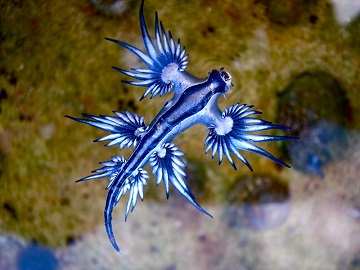600321 Blue Dragon.jpg

Blue dragon sea slugs are beautiful but can deliver a nasty sting. Credit: Sylke Rohrlach, Wikimedia, CC BY-SA 2.0
Blue dragons are among nature’s most efficient recyclers. But what they’re recycling, you don’t want. They absorb the stinging cells of the Portuguese man o’ war and similar creatures, then use them to deliver a nasty sting of their own.
Blue dragons are a type of sea slug. They’re small and elegant -- about an inch long, with wing-like structures that make them look like angels. And they have a shimmering blue color scheme that gives them their formal name: Glaucus atlanticus -- the blue one of the Atlantic.
The little critters inhale a bubble of air that allows them to float at the top of the ocean. In fact, they “hang” upside down from the ocean surface. One side of the dragon’s body is blue-white, while the other is darker blue and silver. That allows it to blend into the sky or the ocean, depending on the viewing angle.
That’s one way the blue dragon stays safe from predators. Another is its powerful sting. Blue dragons eat the man o’ war -- a jellyfish-looking organism with tentacles that extend deep into the water. The tentacles are lined with cells that contain venom. The venom doesn’t affect the blue dragon. Instead, the dragon digests the edible parts of the tentacles, and absorbs the stinging cells. It stores them in small sacs in the “fingers” at the end of its wing-like appendages. When it’s threatened, it stings. And since it stores many cells in each sac, its sting can be more potent than that of the man o’ war -- an efficient but nasty bit of recycling.

